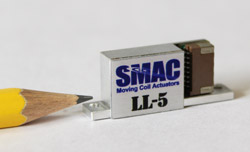
Posted to News on 7th Mar 2019, 09:06
Innovations in moving-coil actuator technology
In this second technical note on moving-coil actuators, Ed Neff, President of SMAC Moving Coil Actuators (MCA), describes how moving-coil technology is evolving rapidly and offering a competitive alternative to pneumatic drives and moving-magnet rotary motors.

Moving-coil technology has been around for a long time and works in both rotary and linear motors. In brush-type rotary servo motors based on moving-coil technology, the brush provides the means for current to reach the coil. In contrast, single-pole linear motors - often called voice coils - are at the heart of many speakers.
The introduction of high-strength neodymium magnets has greatly expanded the applicability of moving-coil actuators in motion applications, as actuators with these magnets output high force (or torque).
The light moving mass of their coils makes the actuators excel in many industrial applications because it allows for high cycle rates up to twice that of pneumatic or ball screw actuators. In addition, moving-coil actuators have:
- Long cycle life - up to 10 times that of pneumatic or ball screw linear actuators
- High repeatability over each cycle - to 10 per cent the variance found in pneumatic devices
- Programmable force and torque output
- The ability to provide movement for very slow speed applications.
Two factors restrict the technology's wider implementation.
1. Cost: Moving-coil linear motors (and their accompanying motion controllers) have until recently cost five times more than pneumatic cylinders and valves of comparable size, and triple that of stepper-motor-based ball screw actuators.
2. Current input: Moving-coil actuators require a mode to get current to the coil - via brushes for rotary actuators and flex cables for linear variations. The former wears out and the latter is limited to strokes of about 500mm or shorter.
Cost reductions
Even so, this is changing, with moving-coil actuators seeing an uptick in use for several reasons relating to simplicity and cost effectiveness:
1. Encoder cost has dropped to below $15; this is mostly due to the development of low-cost chips by a number of makers and the development of low-cost plastic scales.
2. The cost (and size) of motion controllers and amplifiers have also dropped significantly. Volume pricing is now approaching $100 per axis and will continue to decrease. This is due in part to the increased use of servo motors in automotive applications.

- No soldering
- Resistance variation to 1 per cent of that of wound coils
- Very low-cost tool-up of new designs - with a typical expenditure of about $5000
- Ability to print coil shapes that are impossible to wind
- Ability to integrate the flex cable, encoder and main connector into a printed flex circuit (thereby reducing part count and assembly cost)
4. Magnet manufacture. Another factor shrinking the price of certain moving-coil actuators is the way in which some manufacturers reduce the cost of the magnets by cutting long magnets to size and magnetizing them in-house.
5. Certain manufacturers can also replace linear guides with flexures for short strokes of less than 30mm to leverage the fact that flexures can cost less than $1.
Today, moving-coil servo actuators with built-in controller amplifiers are priced at around $350 (for volume orders) and are therefore comparable in price to actuators that incorporate ball screws - though they are still two to three times the cost of pneumatic systems. That said, prices are projected to drop another 35 per cent as the factors listed above begin to affect the market.
The other factor restricting the technology's wider implementation is its need for a brush or flex cable. Here a solution could be on the horizon. University of Eindhoven researchers have demonstrated wireless power transmission on moving coil rotating servo motors. It is technically feasible to apply this not only to rotary moving-coil motors but to linear actuators as well. The main hurdles here are cost and the size of the power-transmitting components. But advances continue, so expect this technology to appear on the market in the near future.
Learn more at www.smac-mca.co.uk.
The first Technical Note in the series from SMAC can be read here: What is a moving coil actuator?.
Want the latest machine building news straight to your inbox? Become a MachineBuilding member for free today >>

















